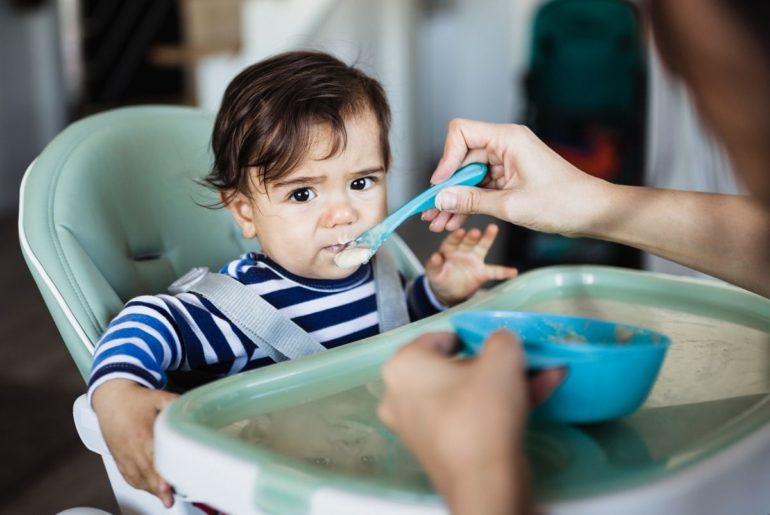You’ve likely seen the news reports that a House Oversight subcommittee investigation found significant levels of toxins in popular baby foods this month, which aligns with independent research done in 2019. Understandably, the report sparked concern—but many are still left with questions. If you’re unsure how this issue might impact you and your family, below are the five main things you should know.
Which toxins were found?
Specifically, the report noted that “commercial baby foods are tainted with significant levels of toxic heavy metals, including arsenic, lead, cadmium and mercury.” The levels were said to be dangerously high, so much so that they “eclipse” the amount of these metals that are allowed in bottled water. Their findings included results up to 91 times the allowed arsenic level, up to 177 times the lead level, up to 69 times the cadmium level, and up to 5 times the mercury level.
Baby food manufacturers knew that these toxins were present, and even permit these high levels in their company standards. But since technically the Food and Drug Administration (FDA) only has one finalized standard (it allows no more than 100 ppb inorganic arsenic, but even that limit only applies to infant rice cereal), the companies did nothing to correct the issue or inform consumers of the danger. The report shows that the Trump administration was informed about this problem by some of the manufacturers on August 1, 2019, but nothing was done to address it. “We provided information to the subcommittee nearly a year ago and invited more dialogue on this important issue but never received any additional inquiries,” Walmart said in a statement.
What are the potential health impacts?
According to the report, “Even low levels of exposure can cause serious and often irreversible damage to brain development.” Consuming toxic heavy metals like those found in baby food in the report can lead to significant changes in a baby’s neurological development and long-term cognitive function. Exposure can cause permanently lowered IQ, result in “diminished future economic productivity,” and even impact long term behavior, increasing the risk of future criminal and antisocial behavior.
Which brands were tested?
The investigation called for detailed information from seven of the biggest baby food makers in the United States. Four companies responded (Nurture/HappyBABY, Beech-Nut, Gerber, and Hain which sells baby food under the brand Earth’s Best Organic), and three refused to cooperate.
While the news from the documentation and test results that were provided painted a grim picture, investigators were “greatly concerned” that the three companies that refused to respond (Walmart, Sprout Organic Foods, and Campbell—which uses the brand Plum Organics for their baby foods) could be hiding even higher levels of toxic substances than their competitors. Independent tests of these brands confirmed they contain “concerning levels of toxic heavy metals.”
How can I keep my kids safe from these toxins?
Unfortunately, “there currently isn’t good data to allow for picking certain baby food brands over others when it comes to heavy metal contamination” according to Dr. Leonardo Trasande, a pediatrics professor at NYU Grossman School of Medicine and director of the Center for the Investigation of Environmental Hazards at NYU Langone in New York City. He also reminds parents that it’s not possible to completely remove all these heavy metals from the food supply, since they occur naturally in the air, water, and soil, as well as in other parts of the environment we live in. In fact, the American Academy of Pediatrics (AAP) says, “The low levels of heavy metals found in baby foods likely are a relatively small part of a child’s overall heavy metal exposure risk.”
There are a few things you can do to limit your family’s exposure, both in food and from other sources.
- Feed your child a variety of different foods, to limit their exposure from a single source. The AAP suggests reading labels closely, since many different flavors and blends of baby food can have the same main ingredients (like sweet potatoes), which would mean your baby wasn’t getting a true variety of foods.
- Focus on organic foods, since they’re grown with fewer pesticides (though they often have similar levels of heavy metals as non-organic foods). Better yet, make your own food from fresh ingredients if possible.
- Avoid rice-based baby cereals, which are known to naturally absorb high levels of inorganic arsenic.
- Limit fruit juices, and offer pureed or sliced whole fruit instead. A 2019 report found levels of arsenic and lead in many popular fruit juice brands.
- Wash fresh fruits and vegetables in cool water before preparing and serving.
- Check your home for lead based paint, especially if it was built before 1978.
- Call your local health department to get your water tested if you’re concerned you might have lead pipes or contaminated well water.
- Avoid fish that are high in mercury, especially while pregnant (such as king mackerel, swordfish, and bigeye tuna).
- Avoid smoking or vaping, which may expose kids to cadmium and lead.
What will happen next?
Investigators in the House Oversight committee now call on the FDA to set maximum levels of toxic heavy metals allowed in baby foods, and to require mandatory testing of the finished products. They also want manufacturers to be required to report toxin levels on the labels. The FDA made a statement that it “takes exposure to toxic elements in the food supply extremely seriously,” especially in relation to kids. They’re currently reviewing the report findings, and say their goal is to reduce exposure to toxic elements in foods “to the greatest extent feasible.”
“I look forward to FDA’s careful regulation of these toxic heavy metals in baby foods, followed by strict compliance requirements and mandatory consumer labels,” Subcommittee Chairman Raja Krishnamoorthi said in a statement.







